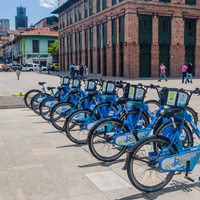Driving in Santa Marta
Summary: Driving in a new country can be daunting. These tips offer insight into what to expect when driving in Santa Marta.
1. Understanding the Driving Culture
Driving in Santa Marta, like many parts of Colombia, can be a bit chaotic for those not used to it. Traffic rules are often not strictly adhered to and drivers can be aggressive. It's important to be alert and cautious at all times. Also, be prepared for motorbikes weaving in and out of traffic.
2. Type of Car to Use
Given the state of some roads, especially in rural areas, a 4x4 vehicle is often recommended. However, in the city, any type of car is suitable. It's worth noting that smaller cars might be easier to maneuver and park in busy areas.
3. Parking Situation
Finding parking in Santa Marta can be challenging, especially in the city center. Some areas have metered parking, while others require a parking permit. Parking is not overly expensive, but it's advisable to always park in a secured lot or garage when possible.
4. Driving with an International License
Foreigners can drive with an international license in Colombia for up to 180 days. After this period, you will need to obtain a Colombian driver's license.
5. Obtaining a Colombian Driver's License
To get a Colombian driver's license, you will need to pass a driving test and a theoretical exam. You will also need to provide a copy of your passport, a medical certificate, and proof of residency. It's advisable to contact the local transit authority or a driving school for the most accurate and up-to-date information.
6. Be Aware of the "Pico y Placa" Rule
Colombia has a driving restriction rule known as "Pico y Placa", which restricts certain vehicles from driving during peak hours based on the last digit of their license plate. Make sure to check the current restrictions to avoid fines.
7. Always Have Your Documents
Always carry your driver's license, passport, and vehicle registration when driving. Police checkpoints are common and you may be asked to show these documents.
8. Be Prepared for Unexpected Road Conditions
While main roads in Santa Marta are generally in good condition, be prepared for unexpected potholes or roadworks. Also, during the rainy season, some roads may be flooded or blocked by landslides.
About the Author
 Betsy Burlingame is the Founder and President of Expat Exchange and is one of the Founders of Digital Nomad Exchange. She launched Expat Exchange in 1997 as her Master's thesis project at NYU. Prior to Expat Exchange, Betsy worked at AT&T in International
and Mass Market Marketing. She graduated from Ohio Wesleyan University
with a BA in International Business and German.
Betsy Burlingame is the Founder and President of Expat Exchange and is one of the Founders of Digital Nomad Exchange. She launched Expat Exchange in 1997 as her Master's thesis project at NYU. Prior to Expat Exchange, Betsy worked at AT&T in International
and Mass Market Marketing. She graduated from Ohio Wesleyan University
with a BA in International Business and German.
Some of Betsy's articles include 12 Best Places to Live in Portugal, 7 Best Places to Live in Panama and 12 Things to Know Before Moving to the Dominican Republic. Betsy loves to travel and spend time with her family. Connect with Betsy on LinkedIn.
Additional Information:
- Public Transportation in Santa Marta
- Best Markets in Santa Marta
- Retire in Santa Marta Guide
- 7 Tips for Living in Santa Marta
- Pros & Cons of Living in Santa Marta
- Driving in Santa Marta
- The Essential Guide to Santa Marta
- Health Care in Santa Marta
- Cost of Living in Santa Marta
- Healthcare & Health Insurance in Colombia
- Best Places to Live in Colombia
- Real Estate in Colombia
- Understanding Mental Health in Colombia
- Pros and Cons of Living in Colombia 2025
- 2025 Guide to Moving to Colombia





